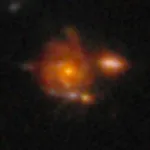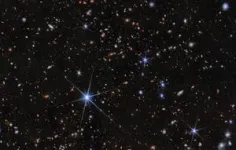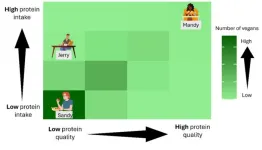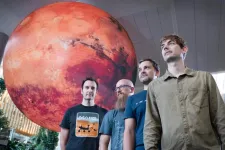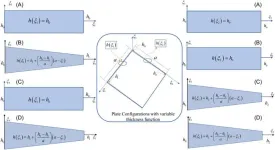(Press-News.org) Large, grand-design spiral galaxies like our own Milky Way are common in the nearby Universe. But they have proven hard to find in the early Universe, which is consistent with expectations that large disks with spiral arms should take many billions of years to form. However, assistant astronomer Christina Williams of NSF NOIRLab, which is funded by the U.S. National Science Foundation, has discovered a surprisingly mature spiral galaxy just one billion years after the Big Bang [1]. This is the most distant, earliest known spiral galaxy in the Universe.
This galaxy, named Zhúlóng — meaning ‘Torch Dragon’ in Chinese mythology, a creature associated with light and cosmic time — was discovered as part of the PANORAMIC Survey. This project is being conducted with the James Webb Space Telescope (JWST) and is co-led by Williams and Pascal Oesch of the University of Geneva (UNIGE).
The research was motivated by building a wide-area imaging survey using JWST to complement future wide-area surveys based out of NOIRLab, such as the upcoming Legacy Survey of Space and Time (LSST), which will be conducted using the NSF–DOE Vera C. Rubin Observatory.
“Wide-area surveys are necessary to discover rare, massive galaxies,” says Williams, co-author on the paper presenting these results. “We were hoping to discover massive and bright galaxies across the earliest epochs of the Universe to understand how massive galaxies form and evolve, which helps to interpret the later epochs of their evolution that will be observed with the LSST.”
Zhúlóng has a surprisingly mature structure that is unique among distant galaxies, which are typically clumpy and irregular. It resembles galaxies found in the nearby Universe and has a mass and size similar to those of the Milky Way. Its structure shows a compact bulge in the center with old stars, surrounded by a large disk of younger stars that concentrate in spiral arms.
This is a surprising discovery on several fronts. First, it shows that mature galaxies that resemble those in our neighborhood can develop much earlier in the Universe than was previously thought possible. Second, it has long been theorized that spiral arms in galaxies take many billions of years to form, but this galaxy demonstrates that spiral arms can also develop on shorter timescales. There is no other galaxy like Zhúlóng that astronomers know of during this early era of the Universe.
“It is really exciting that this galaxy resembles a grand-design spiral galaxy like our Milky Way,” says Williams. “It is generally thought that it takes billions of years for this structure to form in galaxies, but Zhúlóng shows that this could also happen in only one billion years.”
The rarity of galaxies like Zhúlóng suggests that spiral structures could be short-lived at this epoch of the Universe. It’s possible that galactic mergers, or other evolutionary processes that are more common in the early Universe, might destroy the spiral arms. Thus, spiral structures might be more stable later in cosmic time, which is why they are more common in our neighborhood.
The PANORAMIC survey is novel in that it is one of the first JWST projects to use “pure parallel mode” — an efficient observing strategy in which a second camera collects additional images while JWST’s main camera is pointed elsewhere. “It was definitely an adventure to be one of the first to use a new observing mode on a new telescope,” says Williams.
Future JWST and Atacama Large Millimeter/submillimeter Array (ALMA) observations will help confirm Zhúlóng’s properties and reveal more about its formation history. As new wide-area extragalactic surveys continue, astronomers expect to find more such galaxies, offering fresh insights into the complex processes shaping the early Universe.
Notes
[1] Zhúlóng was discovered at redshift 5.2, which equates to a light-travel time of about 12.5 billion years.
More information
This research was presented in a paper titled “PANORAMIC: Discovery of an Ultra-Massive Grand-Design Spiral Galaxy at z∼5.2” appearing in Astronomy & Astrophysics. DOI: 10.1051/0004-6361/202453487
The team is composed of Mengyuan Xiao (University of Geneva), Christina C. Williams (NSF NOIRLab, University of Arizona), Pascal A. Oesch (University of Geneva, University of Copenhagen), David Elbaz (Université Paris Cité), Miroslava Dessauges-Zavadsky (University of Geneva), Rui Marques-Chaves (University of Geneva), Longji Bing (University of Sussex), Zhiyuan Ji (University of Arizona), Andrea Weibel (University of Geneva), Rachel Bezanson (University of Pittsburgh), Gabriel Brammer (University of Copenhagen), Caitlin Casey (University of California, University of Texas at Austin, University of Copenhagen), Aidan P. Cloonan (University of Massachusetts Amherst), Emanuele Daddi (Université Paris Cité), Pratika Dayal (University of Groningen), Andreas L. Faisst (Caltech/IPAC), Marijn Franx (Leiden University), Karl Glazebrook (Swinburne University of Technology), Anne Hutter (University of Copenhagen), Jeyhan S. Kartaltepe (Rochester Institute of Technology), Ivo Labbe (Swinburne University of Technology), Guilaine Lagache (Aix-Marseille Université), Seunghwan Lim (University of Cambridge), Benjamin Magnelli (Université Paris Cité), Felix Martinez (Rochester Institute of Technology), Michael V. Maseda (University of Wisconsin-Madison), Themiya Nanayakkara (Swinburne University of Technology), Daniel Schaerer (University of Geneva), and Katherine E. Whitaker (University of Massachusetts Amherst).
NSF NOIRLab, the U.S. National Science Foundation center for ground-based optical-infrared astronomy, operates the International Gemini Observatory (a facility of NSF, NRC–Canada, ANID–Chile, MCTIC–Brazil, MINCyT–Argentina, and KASI–Republic of Korea), NSF Kitt Peak National Observatory (KPNO), NSF Cerro Tololo Inter-American Observatory (CTIO), the Community Science and Data Center (CSDC), and NSF–DOE Vera C. Rubin Observatory (in cooperation with DOE’s SLAC National Accelerator Laboratory). It is managed by the Association of Universities for Research in Astronomy (AURA) under a cooperative agreement with NSF and is headquartered in Tucson, Arizona.
The scientific community is honored to have the opportunity to conduct astronomical research on I’oligam Du’ag (Kitt Peak) in Arizona, on Maunakea in Hawai‘i, and on Cerro Tololo and Cerro Pachón in Chile. We recognize and acknowledge the very significant cultural role and reverence of I’oligam Du’ag to the Tohono O’odham Nation, and Maunakea to the Kanaka Maoli (Native Hawaiians) community.
Links
Read the paper: PANORAMIC: Discovery of an Ultra-Massive Grand-Design Spiral Galaxy at z∼5.2
University of Geneva press release
James Webb Space Telescope
Check out other NOIRLab Science Releases END
NSF NOIRLab astronomer discovers oldest known spiral galaxy in the Universe
The discovery tells astronomers that galaxies resembling the Milky Way can develop much earlier in the Universe than was previously thought possible
2025-04-16
ELSE PRESS RELEASES FROM THIS DATE:
Iron Age purple dye "factory" in Israel was in operation for almost 500 years, using mollusks in large-scale specialized manufacturing process
2025-04-16
Iron Age purple dye "factory" in Israel was in operation for almost 500 years, using mollusks in large-scale specialized manufacturing process
Article URL: https://plos.io/44elLDX
Article title: Tel Shiqmona during the Iron Age: A first glimpse into an ancient Mediterranean purple dye ‘factory’
Author countries: U.S., Israel
Funding: The author(s) received no specific funding for this work. END ...
Even vegans who get enough total protein may fall short for some essential amino acids
2025-04-16
In a new study of people with long-term vegan diets, most ate an adequate amount of total daily protein, but a significant proportion did not meet required levels of the amino acids lysine and leucine. Bi Xue Patricia Soh and colleagues at Massey University, New Zealand, present these findings in the open-access journal PLOS One on April 16, 2025.
Proteins are made up of various molecular “building blocks” known as amino acids. While the human body can synthesize most of the amino acids we need to live, we completely rely on the ...
RoboBee comes in for a landing
2025-04-16
The Harvard RoboBee has long shown it can fly, dive, and hover like a real insect. But what good is the miracle of flight without a safe way to land?
A storied engineering achievement by the Harvard Microrobotics Laboratory, the RoboBee is now outfitted with its most reliable landing gear to date, inspired by one of nature’s most graceful landers: the crane fly.
Publishing in Science Robotics, the team led by Robert Wood, the Harry Lewis and Marlyn McGrath Professor of Engineering and Applied Sciences in the John A. Paulson School ...
“Ban-the-Box” policy did not effectively help job applicants with criminal records in one analysis
2025-04-16
Analysis of job applicant data from one large employer suggests that a policy meant to improve employment prospects for people with criminal records did not actually lead to changes in job offers for people with records. Deborah Weiss of Northwestern University, U.S., and colleagues present these findings in the open-access journal PLOS One on April 16, 2025.
Parts of the U.S. have introduced “Ban-the-Box” (BTB) laws, which aim to improve job prospects for people with criminal records. ...
Sunscreen, clothes and caves may have helped Homo sapiens survive 41,000 years ago
2025-04-16
ANN ARBOR—Ancient Homo sapiens may have benefitted from sunscreen, tailored clothes and the use of caves during the shifting of the magnetic North Pole over Europe about 41,000 years ago, new University of Michigan research shows.
These technologies could have protected Homo sapiens living in Europe from harmful solar radiation. Neanderthals, on the other hand, appear to have lacked these technologies and disappeared around 40,000 years ago, according to the study, published in Science Advances and led by researchers at Michigan Engineering and the U-M Department of Anthropology.
The team found ...
"Big surprise": astronomers find planet in perpendicular orbit around pair of stars
2025-04-16
Astronomers have found a planet that orbits at an angle of 90 degrees around a rare pair of peculiar stars. This is the first time we have strong evidence for one of these ‘polar planets’ orbiting a stellar pair. The surprise discovery was made using the European Southern Observatory’s Very Large Telescope (VLT).
Several planets orbiting two stars at once, like the fictional Star Wars world Tatooine, have been discovered in the past years. These planets typically occupy orbits that roughly align with the plane in which their host stars orbit each ...
Astronomers find rare twist in exoplanet’s twin star orbit
2025-04-16
Astronomers have discovered a planet that orbits at a 90-degree angle around a rare pair of strange stars – a real-life ‘twist’ on the fictional twin suns of Star Wars hero Luke Skywalker’s home planet of Tatooine.
The exoplanet, named 2M1510 (AB) b, orbits a pair of young brown dwarfs — objects bigger than gas-giant planets but too small to be proper stars. Only the second pair of eclipsing brown dwarfs known – this is the first exoplanet found on a right-angled path to the orbit of its two host stars.
An international team of researchers led ...
Crystal clues on Mars point to watery and possibly life-supporting past
2025-04-16
A QUT-led study analysing data from NASA’s Perseverance rover has uncovered compelling evidence of multiple mineral-forming events just beneath the Martian surface – findings that bring scientists one step closer to answering the profound question: did life ever exist on Mars?
The QUT research team led by Dr Michael Jones, from the Central Analytical Research Facility and the School of Chemistry and Physics, includes Associate Professor David Flannery, Associate Professor Christoph Schrank, Brendan Orenstein and Peter Nemere, together with researchers from North America and Europe.
The findings were published in the prestigious journal ...
Microbes in Brooklyn Superfund site teach lessons on fighting industrial pollution
2025-04-16
Using advanced DNA sequence analysis, a research team led by NYU Tandon School of Engineering's Assistant Professor Elizabeth Hénaff has discovered that tiny organisms in Brooklyn's highly contaminated Gowanus Canal have developed a comprehensive collection of pollution-fighting genes.
The findings were published in the Journal of Applied Microbiology on April 15, 2025.
The team identified 455 species of microorganisms wielding 64 different biochemical pathways to degrade pollutants ...
Porous and powerful: How multidirectional grading enhances piezoelectric plate performance
2025-04-16
Piezoelectric materials have long been celebrated for their ability to convert mechanical energy into electrical energy, making them indispensable in smart systems for sensing, actuation, and vibration control. However, incorporating porosity and multidirectional grading into these materials introduces a host of challenges in understanding their behavior under varying environmental conditions. These complexities are further compounded by the interaction of hygrothermal conditions with electrical and mechanical loads. As a result, there is a pressing need for more in-depth research to predict the real-world performance of these materials.
Published ...
LAST 30 PRESS RELEASES:
Making lighter work of calculating fluid and heat flow
Normalizing blood sugar can halve heart attack risk
Lowering blood sugar cuts heart attack risk in people with prediabetes
Study links genetic variants to risk of blinding eye disease in premature infants
Non-opioid ‘pain sponge’ therapy halts cartilage degeneration and relieves chronic pain
AI can pick up cultural values by mimicking how kids learn
China’s ecological redlines offer fast track to 30 x 30 global conservation goal
Invisible indoor threats: emerging household contaminants and their growing risks to human health
Adding antibody treatment to chemo boosts outcomes for children with rare cancer
Germline pathogenic variants among women without a history of breast cancer
Tanning beds triple melanoma risk, potentially causing broad DNA damage
Unique bond identified as key to viral infection speed
Indoor tanning makes youthful skin much older on a genetic level
Mouse model sheds new light on the causes and potential solutions to human GI problems linked to muscular dystrophy
The Journal of Nuclear Medicine ahead-of-print tip sheet: December 12, 2025
Smarter tools for peering into the microscopic world
Applications open for funding to conduct research in the Kinsey Institute archives
Global measure underestimates the severity of food insecurity
Child survivors of critical illness are missing out on timely follow up care
Risk-based vs annual breast cancer screening / the WISDOM randomized clinical trial
University of Toronto launches Electric Vehicle Innovation Ontario to accelerate advanced EV technologies and build Canada’s innovation advantage
Early relapse predicts poor outcomes in aggressive blood cancer
American College of Lifestyle Medicine applauds two CMS models aligned with lifestyle medicine practice and reimbursement
Clinical trial finds cannabis use not a barrier to quitting nicotine vaping
Supplemental nutrition assistance program policies and food insecurity
Switching immune cells to “night mode” could limit damage after a heart attack, study suggests
URI-based Global RIghts Project report spotlights continued troubling trends in worldwide inhumane treatment
Neutrophils are less aggressive at night, explaining why nighttime heart attacks cause less damage than daytime events
Menopausal hormone therapy may not pose breast cancer risk for women with BRCA mutations
Mobile health tool may improve quality of life for adolescent and young adult breast cancer survivors
[Press-News.org] NSF NOIRLab astronomer discovers oldest known spiral galaxy in the UniverseThe discovery tells astronomers that galaxies resembling the Milky Way can develop much earlier in the Universe than was previously thought possible

